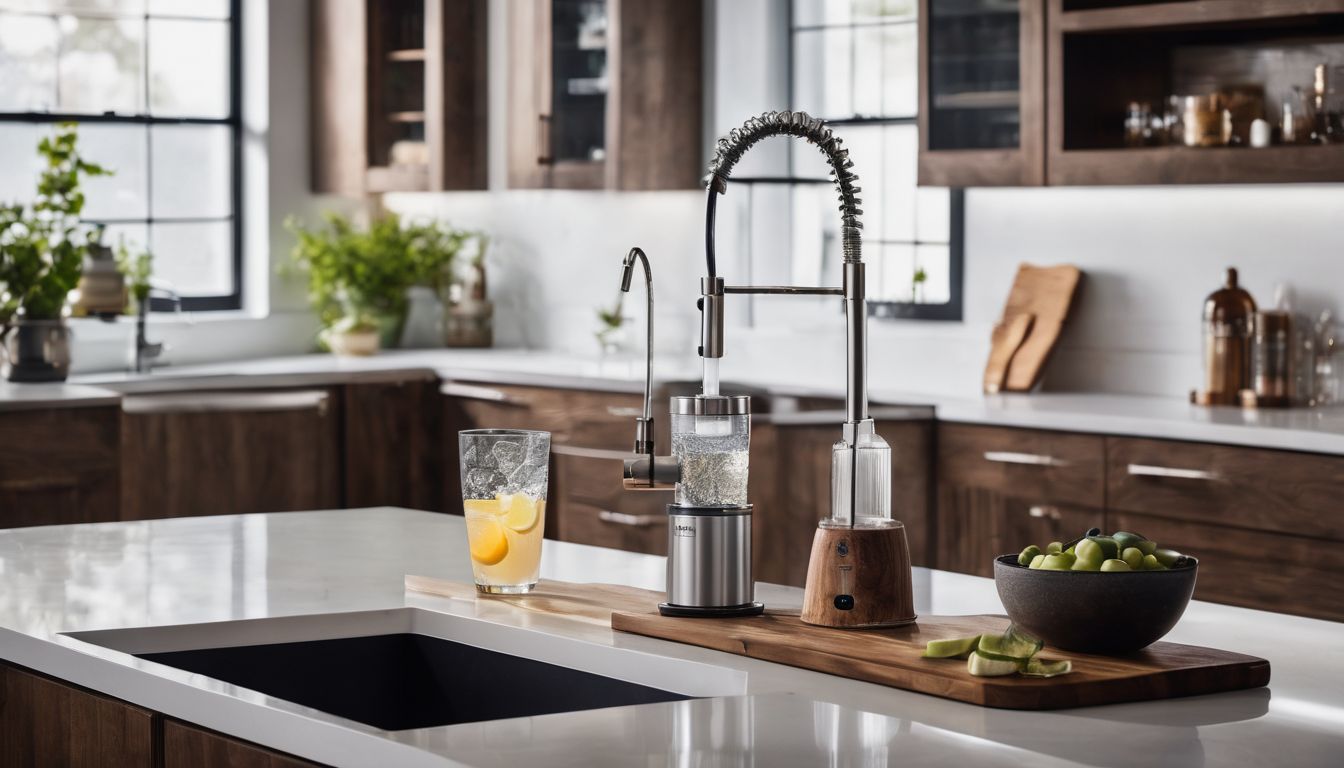Choosing the perfect flooring is not just about aesthetics; it’s also about making responsible choices for our planet. Did you know that sustainable flooring can reduce your carbon footprint and even improve your home’s indoor air quality? Our guide will uncover a variety of eco-friendly options, ensuring you make an informed decision that aligns with both style and sustainability.
Dive in to find the green solution that floors you!
Key Takeaways
- Sustainable flooring like bamboo, cork, and reclaimed wood helps to lower environmental impact by using renewable or recycled materials.
- Eco-friendly floor coatings such as water-based polyurethane and natural oils contribute to LEED points for sustainable building projects.
- Technological advancements are continuously improving sustainable flooring options, making them more durable, eco-friendly and diverse in design.
- Opting for sustainable flooring can improve indoor air quality by reducing the presence of harmful volatile organic compounds (VOCs).
- When selecting sustainable flooring materials, consider factors like source sustainability certifications (e.g., FSC), durability of the material, and environmentally friendly finishes.
What is Sustainable Flooring?
Sustainable flooring refers to materials that are environmentally friendly and have a minimal impact on the planet. Using sustainable flooring has benefits for both the environment and indoor air quality.
Definition
Sustainable flooring encompasses a range of eco-friendly options designed to minimise environmental impact. Materials like bamboo, cork, and reclaimed wood serve as excellent alternatives to traditional hardwood floors, offering durability along with a reduced carbon footprint.
These green choices not only help in conserving natural resources but also contribute to healthier indoor air quality due to their low emission rates.
Eco-conscious consumers often select sustainable flooring materials for their recyclability and renewability. This means once the floor has served its purpose, it can be repurposed or safely returned to the earth without causing harm.
Opting for such materials fulfills a commitment towards environmental stewardship while aligning with modern aesthetic and functional demands in home design.
Benefits of using sustainable flooring
Choosing sustainable flooring offers numerous benefits, including:
- Lower environmental impact: Sustainable flooring uses renewable or recycled materials, reducing the demand for new resources.
- Improved indoor air quality: Many sustainable flooring options are low in volatile organic compounds (VOCs), contributing to healthier indoor environments.
- Long-term cost savings: Sustainable flooring can be more durable and require less maintenance, saving money over time.
- Support for ethical practices: By choosing sustainable flooring, you support responsible sourcing and manufacturing practices.
Types of Sustainable Flooring
Explore a variety of sustainable flooring options, from engineered wood and traditional wood flooring to herringbone, bamboo, cork, and concrete flooring. Each type offers unique benefits for environmentally conscious individuals looking for eco-friendly flooring solutions.
https://www.youtube.com/watch?v=i-LAnShDPZc
Engineered wood flooring
Engineered wood flooring is made of layers of real wood that are bonded together, making it a durable and sustainable option for eco-conscious homeowners. The top layer is typically hardwood, while the lower layers are composed of high-quality plywood or fibreboard.
This construction not only enhances stability but also allows for wider planks than traditional solid wood flooring. By using this type of flooring, you can enjoy the beauty and warmth of natural wood while making an environmentally friendly choice.
This type of flooring offers a more versatile installation option as it can be laid directly over concrete or existing flooring. Engineered wood is also less prone to expansion and contraction in humid conditions compared to solid wood floors, making it an ideal choice for areas with varying moisture levels.
Traditional wood flooring
Transitioning from Engineered wood flooring to Traditional wood flooring, traditional wood flooring comprises solid hardwood planks that are milled from a single piece of timber. This type of flooring offers a timeless aesthetic and durable functionality, making it an ideal choice for those looking for sustainable and long-lasting options.
Solid hardwood flooring comes in various species such as oak, maple, walnut, and cherry, providing versatility in design while maintaining its eco-friendly appeal. Additionally, with proper maintenance and care, traditional wood flooring can last for generations and can be rejuvenated by refinishing rather than replacing.
When choosing traditional wood flooring as your sustainable option, ensure the source of the timber is certified by reputable organisations such as the Forest Stewardship Council (FSC) or Programme for the Endorsement of Forest Certification (PEFC).
Herringbone flooring
Herringbone flooring offers a classic and timeless look, made from sustainable wood materials. It is an environmentally friendly choice for those seeking stylish yet eco-conscious options.
The intricate pattern of herringbone adds visual interest to any space, while the use of sustainable wood aligns with conservation efforts. This type of flooring is not only durable but also renewable, making it a popular choice for environmentally conscious individuals looking for long-lasting and visually appealing flooring solutions.
Herringbone floors incorporate natural wood in a stylish and sustainable manner, embracing both elegance and environmental responsibility.
Bamboo flooring
Bamboo flooring offers a sustainable and environmentally friendly option for your home. It is made from the fast-growing bamboo plant, making it a renewable resource. The production process also emits lower levels of greenhouse gases compared to traditional wood flooring, reducing its environmental impact.
Bamboo flooring is durable and easy to maintain, with a wide range of styles and finishes available, providing both aesthetic appeal and practicality. Its natural beauty brings warmth and sophistication to any space while contributing to sustainable living.
Bamboo flooring provides an eco-friendly alternative that supports conservation efforts without compromising on style or quality. As a result, it has become increasingly popular among environmentally conscious individuals seeking green building solutions.
Cork flooring
Transitioning from bamboo to cork flooring, another sustainable option is found in the form of cork flooring. Harvested from the bark of cork oak trees, this renewable material provides a comfortable and resilient floor surface.
Cork’s natural insulation properties make it an energy-efficient choice for maintaining indoor temperatures. Additionally, its sound-absorbing qualities reduce noise levels, creating a quieter environment within your living space.
The use of cork also contributes to environmental preservation as it allows trees to continue growing after harvesting.
Concrete flooring
Transitioning from cork to concrete flooring, sustainable options continue with the versatility and durability of concrete. Concrete flooring is an eco-friendly choice due to its long lifespan, low maintenance requirements, and excellent thermal properties.
It can be sourced locally, reducing transportation emissions and can also utilise recycled materials, making it a green choice for environmentally conscious individuals. The use of polished or stained concrete finishes adds aesthetic appeal while maintaining sustainability.
Concrete flooring offers a durable and versatile option for sustainable building materials. Its long lifespan and minimal maintenance make it an attractive choice for eco-conscious consumers looking for practical yet environmentally friendly flooring solutions.
Factors to Consider When Choosing Sustainable Flooring
Consider the material source, durability and finishes when choosing sustainable flooring for your home or business. These factors play a crucial role in determining the environmental impact and longevity of your flooring choice.
Material source
When choosing sustainable flooring, it’s crucial to consider the material source. Opting for materials from responsibly managed forests or renewable sources such as bamboo and cork helps reduce environmental impact.
Additionally, reclaimed wood flooring and recycled content in other materials are eco-friendly choices that contribute to conservation efforts. Ensuring that the materials used for the flooring come from certified sustainable sources is vital for promoting a healthier environment.
The material source of sustainable flooring plays a significant role in reducing carbon footprint and supporting conservation initiatives. By prioritising materials with minimal environmental impact, individuals can make a positive contribution towards creating more eco-friendly living spaces.
Durability
Sustainable flooring must be durable to stand the test of time. When choosing sustainable flooring, consider its ability to withstand heavy traffic and resist wear and tear. Durability ensures that the flooring lasts longer, reducing the need for frequent replacement and minimising environmental impact.
Look for sustainable flooring materials like bamboo, cork, or engineered wood with a high level of durability. These options are not only environmentally friendly but also long-lasting, making them an ideal choice for eco-conscious individuals looking to make a lasting impact on their living spaces.
Finishes
When considering sustainable flooring, the finishing options play a critical role in maintaining the eco-friendly aspect. Opting for low-VOC or zero-VOC finishes ensures that harmful chemicals are not released into the environment during and after installation.
This conscious choice aligns with the commitment to preserving nature while enjoying durable and aesthetically pleasing flooring.
To further enhance sustainability, natural oil-based finishes provide an excellent alternative to traditional polyurethane coatings, as they promote healthier indoor air quality and reduce environmental impact.
Eco-Friendly Floor Coatings
Explore the different types of eco-friendly floor coatings and how they can contribute to LEED points in sustainable building projects. Read on to discover more about these environmentally friendly options for your flooring needs.
Types of coatings
When choosing eco-friendly floor coatings, consider the following options:
- Water-based polyurethane: This coating is low in volatile organic compounds (VOCs), making it an environmentally friendly choice.
- UV-cured finishes: These coatings are cured instantly using ultraviolet light, reducing the need for harmful chemicals and decreasing drying time.
- Natural oils and waxes: Coatings made from natural oils and waxes provide a sustainable and non-toxic finish for wood floors.
- Plant-based polyurethane: Derived from renewable resources such as soya or castor oil, plant-based polyurethane coatings offer a greener alternative to traditional options.
- Powder coatings: These coatings contain no solvents and emit near-zero VOCs, making them an eco-conscious choice for sustainable flooring materials.
LEED points
To achieve LEED points, consider using sustainable flooring materials that are certified by the Leadership in Energy and Environmental Design (LEED) for their eco-friendly qualities.
Materials such as bamboo, cork, and reclaimed wood can contribute to LEED certification, promoting environmental responsibility and resource efficiency in building projects. By selecting these environmentally friendly options with low volatile organic compounds (VOC), you can enhance indoor air quality while positively impacting the environment.
Strategically choosing sustainable flooring materials helps earn LEED points, indicating a commitment to reducing carbon footprint and promoting healthier living spaces. Bamboo, cork, or reclaimed wood flooring not only offer durability and aesthetic appeal but also help meet green building standards—making them an excellent choice for environmentally conscious individuals aiming to support conservation efforts while creating eco-friendly living environments.
The Future of Sustainable Flooring
The future of sustainable flooring looks promising with ongoing innovations, advancements in technology, and a growing emphasis on reducing the environmental impact of flooring materials.
To learn more about the latest developments in sustainable flooring, keep reading our comprehensive guide.
Innovations
Innovations in sustainable flooring are continuously evolving as technology advances. New materials and manufacturing processes contribute to the development of eco-friendly alternatives.
Advancements such as modular floor designs, which allow for easy installation and maintenance, are becoming more prevalent. Additionally, the use of reclaimed and recycled materials in flooring production provides alternative options that support environmental conservation efforts.
Innovation in sustainable flooring is driven by a commitment to reducing environmental impact while providing durable and aesthetically pleasing options for consumers. As technology continues to progress, we can expect to see even more innovative approaches that benefit both the environment and those who seek eco-conscious flooring solutions.
Advancements in technology
Advancements in technology have led to the development of new sustainable flooring materials, such as eco-friendly wood composites and innovative production methods using renewable resources.
Sustainable flooring manufacturers are integrating digital design technologies to create intricate patterns and textures while reducing material waste. These technological advancements enable the production of high-quality, durable flooring options that meet eco-friendly standards, providing environmentally conscious individuals with a wider range of choices for their homes or commercial spaces.
Innovative techniques like 3D printing and precision engineering have revolutionised sustainable flooring manufacturing, allowing for greater customisation and minimised environmental impact throughout the production process.
Impact on the environment
Sustainable flooring materials have a positive impact on the environment. Using renewable and eco-friendly flooring options helps to reduce the demand for natural resources, minimises waste, and lowers carbon emissions.
By choosing sustainable floor coverings such as bamboo, cork, or recycled wood, individuals can contribute to conservation efforts and support green building solutions.
The production of eco-friendly flooring materials also promotes better indoor air quality by minimising the use of harmful chemicals and toxins commonly found in conventional floor products.
Conclusion
In conclusion, sustainable flooring offers a wide array of eco-friendly options for environmentally conscious individuals. From engineered wood to bamboo and cork, these materials provide durable and stylish choices for green building solutions.
With ongoing innovations and advancements in technology, the future of sustainable flooring looks promising, with a positive impact on the environment. Choosing sustainable flooring not only benefits your space but also supports conservation efforts for a healthier planet.
FAQs
1. What are sustainable flooring materials?
Sustainable flooring materials include eco-friendly options like linoleum, rubber, and carpet made from recyclable or renewable resources that have a low impact on the environment.
2. How is parquet flooring a green choice?
Parquet is considered a green flooring choice when made from sustainable wood or recycled wood, contributing to eco-conscious building solutions.
3. Can I find eco-friendly carpeting for my home?
Yes, you can choose carpets crafted from natural fibers or recycled materials which offer an eco-friendly option for comfortable and stylish floors.
4. Is it possible to get sustainable wood flooring?
Absolutely! Look for labels such as “Ecofriendly wood” or “Natural and sustainable” to ensure your wooden floors come from responsibly managed forests.
5. Are there any benefits of choosing rubber as a flooring material?
Rubber floors are durable, recyclable, and come in various colours; making them practical low-impact and green building friendly choices for places with high foot traffic.





